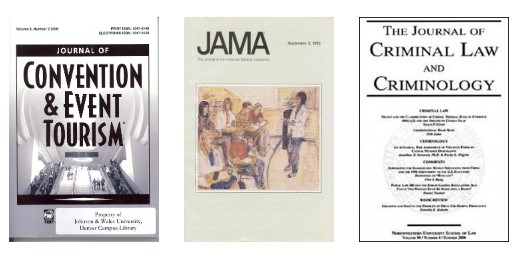
Scholarly Periodicals
Also known as academic, refereed, or peer-reviewed journals.
Author/Authority: Articles written by researchers or scholars in the field who report the results of original research. Other scholars evaluate the research before publication to assure its accuracy, called "peer-review."
Appearance: Generally have a sober, serious look. May contain graphs and charts, but few glossy pages or photographs. Use scholarly language with vocabulary specific to their profession or field.
Audience: Written for academics and professionals.
Citations: Articles include footnotes and a list of citations at the end of the article.
Content: Includes scholarly research for a particular profession or industry.
Frequency: Usually published bimonthly or quarterly.
Examples:

Periodicals: Scholarly vs. Popular
Used with permission of Peabody Library, Vanderbilt University (3:12 length). Retrieved from https://www.youtube.com/watch?v=ysPDZGj3cRA
Library Periodicals
For a complete listing of magazines, journals and newspapers accessible at the Hewes Library, visit the Periodicals A to Z List.
How to Read a Scholarly Article
Used with permission of Kishwaukee College Library (5:10 length). Retrieved from https://youtu.be/EEVftUdfKtQ.
Periodicals: Scholarly vs. Popular
Used with permission of Peabody Library, Vanderbilt University (3:12 length). Retrieved from https://www.youtube.com/watch?v=ysPDZGj3cRA
Library Periodicals
For a complete listing of magazines, journals and newspapers accessible at the Hewes Library, visit the Periodicals A to Z List.
Trade
Also known as industry magazines.
Appearance: Generally attractive and are often illustrated with color photographs.
Audience: Written for industry professionals.
Author/Authority: Articles written by staff writers, may sometimes accept articles from industry professionals. Not peer-reviewed.
Citations: Occasionally list references at the end of the article or provide footnotes within the text.
Content: Include current events, trends, and news within a particular profession or industry.
Frequency: Usually published biweekly or monthly.
Examples:
Scholarly vs. Popular
Used with permission of Harris Learning Library (3:51 length). Retrieved from https://www.youtube.com/watch?v=z6DI7ZiGkVQ&feature=youtu.be.
Scholarly vs. Popular
Used with permission of Peabody Library, Vanderbilt University (3:12 length). Retrieved from https://www.youtube.com/watch?v=ysPDZGj3cRA
How to Read a Scholarly Article
Used with permission of Kishwaukee College Library (5:10 length). Retrieved from https://youtu.be/EEVftUdfKtQ.
How to read a scholarly article
Used with permission of Kishwaukee College Library (5:10 length). Retrieved from https://youtu.be/EEVftUdfKtQ.
Library Periodicals
For a complete listing of magazines, journals and newspapers accessible at the Hewes Library, visit the Periodicals A to Z List.
"Confirmation bias, the tendency to process information by looking for information that is consistent with one’s existing beliefs."
from: "Confirmation Bias" - Encyclopaedia Britannica
When you research, ask yourself:
- How did I find these sources?
- Are all my sources from the same type of source?
- news vs. scholarly source
- diverse media outlets (AdFontes Media Bias Chart)
- Do all my sources say the same thing?
-
Research Tips
- Always evaluate a source for validity
- Try more than one search with multiple keywords
- How might a search for "pro-choice" be different than "anti-abortion" or "pro-life"?
